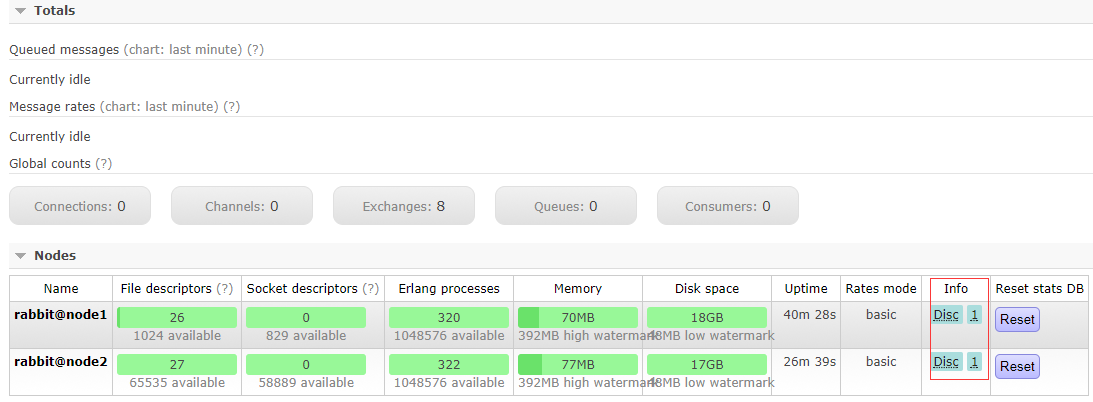Rabbitmq 相关介绍之双机镜像模式集群配置
Posted
tags:
篇首语:本文由小常识网(cha138.com)小编为大家整理,主要介绍了Rabbitmq 相关介绍之双机镜像模式集群配置相关的知识,希望对你有一定的参考价值。
一、环境介绍
系统: Centos 6.7 2.6.32-573.el6.x86_64 node1 172.16.60.187 node2 172.16.60.188 软件包 erlang-19.0.4-1.el6.x86_64.rpm rabbitmq-server-3.6.12-1.el6.noarch.rpm 直接使用rpm包安装!
二、开始配置普通集群
1、设置hosts,是rabbitmq节点可以顺利的互通 在两台服务器上配置/etc/hosts,如下: #cat /etc/hosts 172.16.60.187 node1 172.16.60.188 node2 2、启动2台rabbitmq #service rabbitmq-server start 3、设置不同节点间同一认证的Erlang Cookie 采用从主节点copy的方式保持Cookie的一致性,这里将node1节点的cookie拷贝到node2 #scp /var/lib/rabbitmq/.erlang.cookie [email protected]:/var/lib/rabbitmq/ .erlang.cookie 4、查看Cookie情况 [[email protected] ~]# cat /var/lib/rabbitmq/.erlang.cookie CLAPXRVVRHOJYFPTZVTB [[email protected] ~]# cat /var/lib/rabbitmq/.erlang.cookie CLAPXRVVRHOJYFPTZVTB 5、没有创建普通集群之前,查看集群状态 [[email protected] ~]# rabbitmqctl cluster_status Cluster status of node [email protected] [{nodes,[{disc,[[email protected]]}]}, {running_nodes,[[email protected]]}, {cluster_name,<<"[email protected]">>}, {partitions,[]}, {alarms,[{[email protected],[]}]}] ################################################################ [[email protected] ~]# rabbitmqctl cluster_status Cluster status of node [email protected] [{nodes,[{disc,[[email protected]]}]}, {running_nodes,[[email protected]]}, {cluster_name,<<"[email protected]">>}, {partitions,[]}, {alarms,[{[email protected],[]}]}] 6、创建并部署集群,以node2为例 [[email protected] rabbitmq]# rabbitmqctl stop_app Stopping rabbit application on node [email protected] [[email protected] rabbitmq]# rabbitmqctl join_cluster [email protected] Clustering node [email protected] with [email protected] [[email protected] rabbitmq]# rabbitmqctl start_app Starting node [email protected] 注:根据官方文档,如果有node3,继续加入集群那么就在node3操作,停止app--添加--启动app #rabbitmqctl join_cluster [email protected] 7、查看集群状态 #rabbitmqctl cluster_status Cluster status of node [email protected] [{nodes,[{disc,[[email protected],[email protected]]}]}, {running_nodes,[[email protected],[email protected]]}, {cluster_name,<<"[email protected]">>}, {partitions,[]}, {alarms,[{[email protected],[]},{ra[email protected],[]}]}] 到这里2台服务器构成的普通集群就配置好了。 8、启动管理界面 [[email protected] ~]# rabbitmq-plugins enable rabbitmq_management The following plugins have been enabled: amqp_client cowlib cowboy rabbitmq_web_dispatch rabbitmq_management_agent rabbitmq_management Applying plugin configuration to [email protected] started 6 plugins. ######################################################################### [[email protected] rabbitmq]# rabbitmq-plugins enable rabbitmq_management The following plugins have been enabled: amqp_client cowlib cowboy rabbitmq_web_dispatch rabbitmq_management_agent rabbitmq_management Applying plugin configuration to [email protected] started 6 plugins. 9、配置用户名和密码 [[email protected] ~]# rabbitmqctl add_user admin admin123 Creating user "admin" [[email protected] ~]# rabbitmqctl set_user_tags admin administrator Setting tags for user "admin" to [administrator] [[email protected] ~]# rabbitmqctl set_permissions -p / admin ".*" ".*" ".*" Setting permissions for user "admin" in vhost "/"
在浏览器访问,并查看建状态如下:
 一个集群需要至少有一个disc节点,一个RAM节点,那么我们将node2修改为RAM节点。
一个集群需要至少有一个disc节点,一个RAM节点,那么我们将node2修改为RAM节点。
在node2节点上操作如下: [[email protected] ~]# rabbitmqctl stop_app Stopping rabbit application on node [email protected] [[email protected] ~]# rabbitmqctl change_cluster_node_type ram Turning [email protected] into a ram node [[email protected] ~]# rabbitmqctl start_app Starting node [email protected] 查看是否修改成功 [[email protected] ~]# rabbitmqctl cluster_status Cluster status of node [email protected] [{nodes,[{disc,[[email protected]]},{ram,[[email protected]]}]}, #修改成功 {running_nodes,[[email protected],[email protected]]}, {cluster_name,<<"[email protected]">>}, {partitions,[]}, {alarms,[{[email protected],[]},{[email protected],[]}]}] ######################################################## [[email protected] ~]# rabbitmqctl cluster_status Cluster status of node [email protected] [{nodes,[{disc,[[email protected]]},{ram,[[email protected]]}]}, #修改成功 {running_nodes,[[email protected],[email protected]]}, {cluster_name,<<"[email protected]">>}, {partitions,[]}, {alarms,[{[email protected],[]},{[email protected],[]}]}] 同事通过rabbitmq-magagement界面看到的也是一个Disc一个Ram。
三、配置镜像队列集群
[[email protected] ~]# rabbitmqctl set_policy mirror_queue1 "^" ‘{"ha-mode":"all","ha-sync-mode":"automatic","ha-promote-on-shutdown":"always"}‘ Setting policy "mirror_queue1" for pattern "^" to "{\"ha-mode\":\"all\",\"ha-sync-mode\":\"automatic\",\"ha-promote-on-shutdown\":\"always\"}" with priority "0" 查看 [[email protected] ~]# rabbitmqctl list_policies Listing policies / mirror_queue1 all ^ {"ha-mode":"all","ha-sync-mode":"automatic","ha-promote-on-shutdown":"always"} 0 ####################### [[email protected] ~]# rabbitmqctl list_policies Listing policies / mirror_queue1 all ^ {"ha-mode":"all","ha-sync-mode":"automatic","ha-promote-on-shutdown":"always"} 0
同样的,添加好镜像队列之后,也可以在rabbitmq-management界面看到。
本文出自 “知识体系” 博客,请务必保留此出处http://linuxg.blog.51cto.com/4410110/1967788
以上是关于Rabbitmq 相关介绍之双机镜像模式集群配置的主要内容,如果未能解决你的问题,请参考以下文章